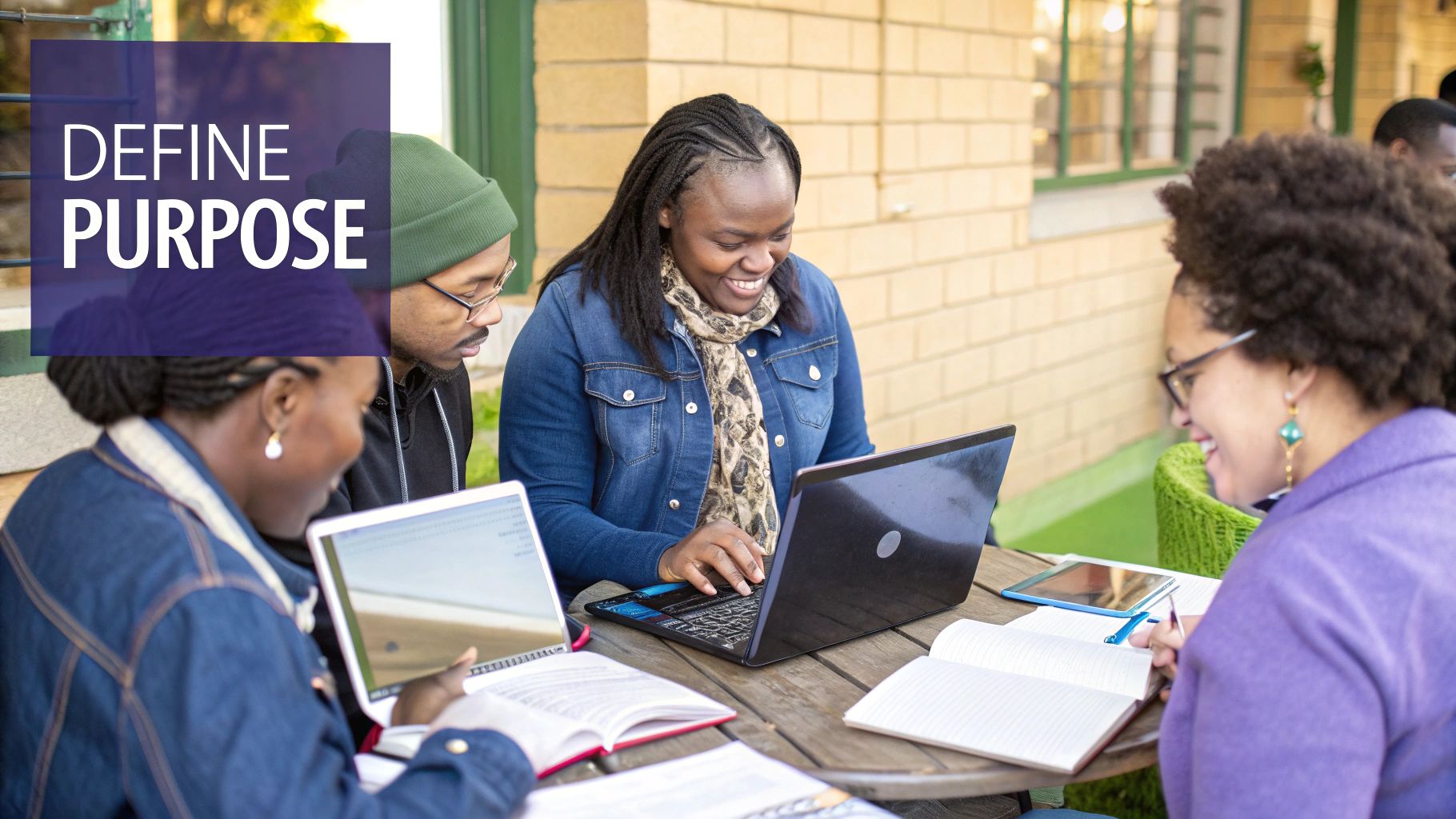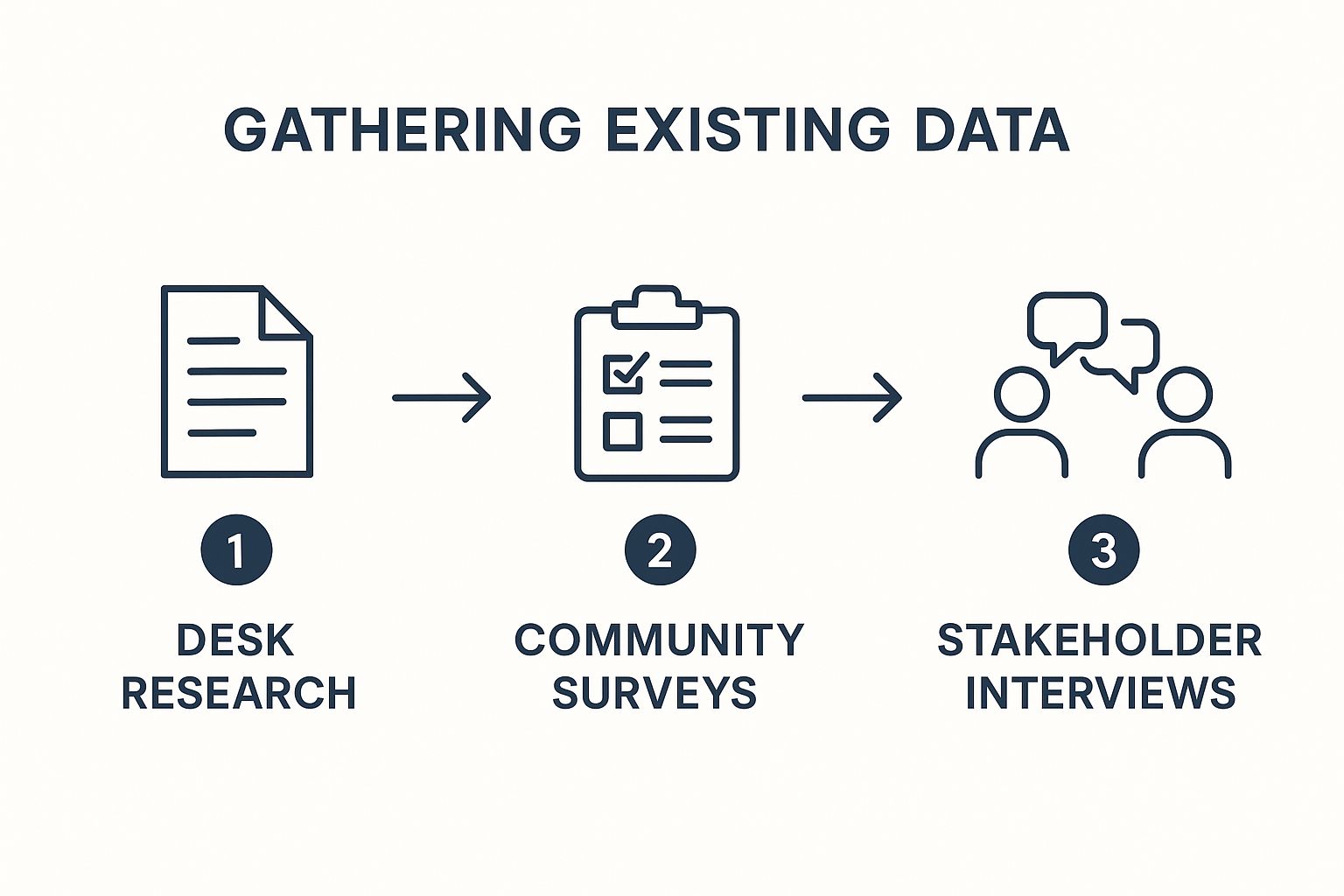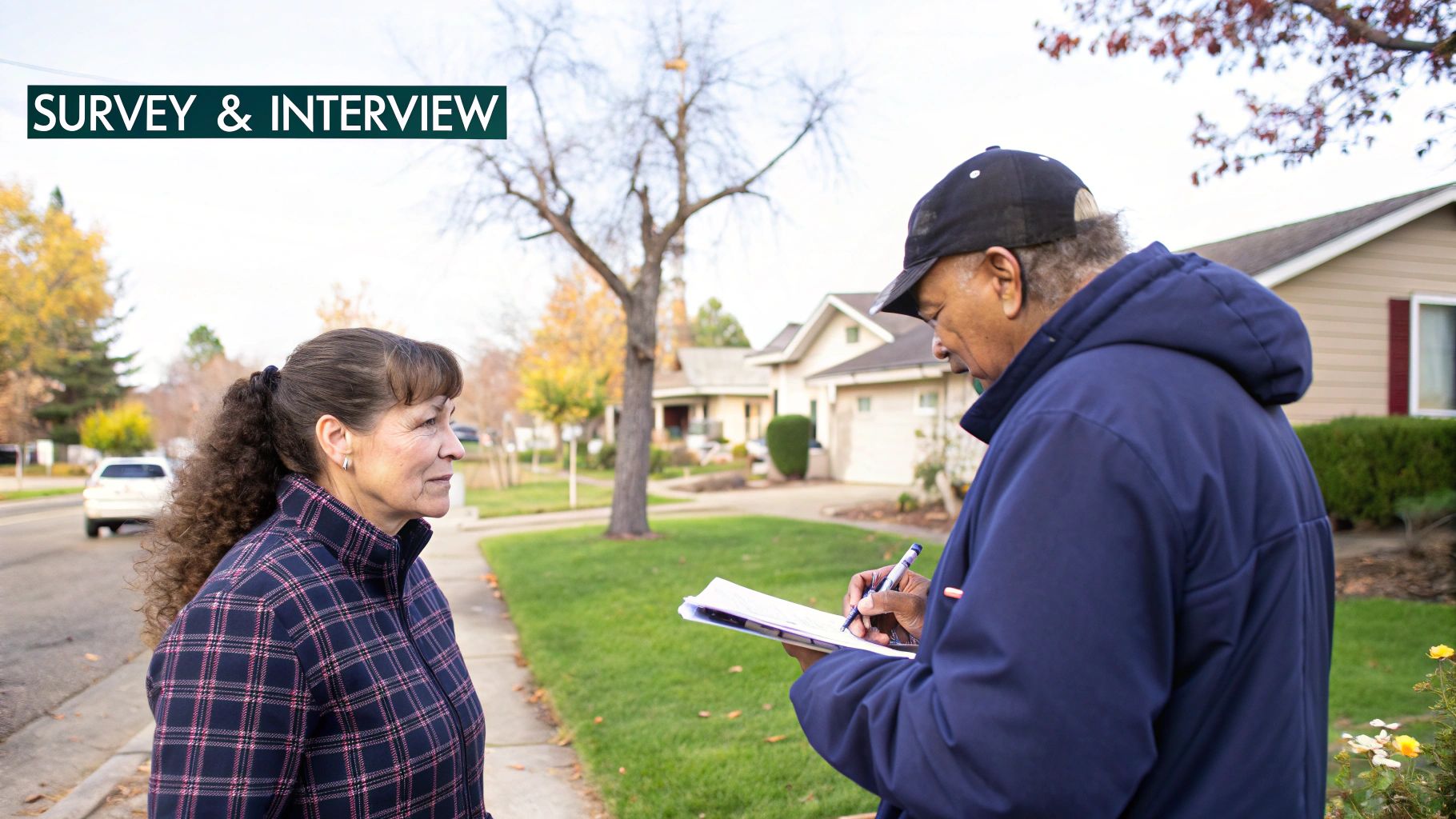
A community needs assessment is your roadmap for making a real difference. It’s a structured way to figure out what’s working in a community and, more importantly, where the gaps are. Think of it as a deep dive into the difference between how things are and how community members want them to be.
This isn't just about listing problems. It's a comprehensive process that involves defining your focus, gathering information directly from residents through things like surveys and focus groups, carefully analyzing what you've learned, and then building a solid plan to tackle the most pressing issues. Getting this right is fundamental to creating programs that truly work and securing the funding to make them happen.
Understanding the Community Needs Assessment
A community needs assessment is much more than a simple report—it's the bedrock of any meaningful community initiative. Its main job is to uncover the real, measurable distance between what a community currently has and what it truly needs to flourish. But it’s not just a problem-finding mission. A great assessment also shines a light on the community's existing strengths and assets, which are the building blocks for sustainable solutions.

Let's say your assessment uncovers a critical lack of affordable childcare. That's a clear need. But what if it also reveals a strong, informal network of retired teachers and grandparents who are looking for ways to stay involved? By connecting that need with that existing asset, you can start building a solution that’s born from the community itself.
A well-executed needs assessment moves through several distinct stages, each with a clear purpose. It's a journey from initial questions to concrete action.
The Core Phases of a Needs Assessment
Each phase builds on the last, ensuring your final action plan is grounded in solid evidence and genuine community input.
Why This Process Matters
From public health departments to small, grassroots nonprofits, organizations everywhere rely on these assessments for very good reasons. First and foremost, they provide the hard data and compelling stories you need to back up grant proposals. A well-documented need is always going to be more persuasive to a funder than a vague assumption.
Beyond just chasing dollars, these assessments are the blueprint for smart program design. They force you to answer tough but essential questions:
- Which services are the most critical right now?
- Who in our community is being overlooked or left behind?
- What are the underlying causes of the challenges we’re seeing on the surface?
Take the Council on Aging of Southwestern Ohio, for example. They use regular assessments to stay in tune with the evolving needs of their community. Their research highlights pressing issues like rising housing costs, transportation gaps, and social isolation. These findings don't just sit on a shelf; they directly shape the council's strategic plans, ensuring resources are aimed at the real-time concerns of the more than 365,000 older adults they serve.
A needs assessment transforms your approach from reactive problem-solving to proactive, strategic planning. It ensures that every dollar spent and every program launched is aimed at a documented, prioritized need.
Ultimately, a thoughtfully conducted assessment does something just as important: it builds trust. When you bring residents and local leaders into the process of naming their own challenges and brainstorming solutions, you empower them. That spirit of collaboration is the secret sauce for the long-term success of any community-based work.
Setting Your Assessment's Scope and Goals

Before you even think about drafting a survey question, you need to pump the brakes. A truly useful assessment starts with a solid plan, built on clear boundaries and well-defined objectives. I've seen too many well-intentioned efforts fizzle out because they skipped this foundational work.
This planning phase is what separates a strategic assessment from a simple box-ticking exercise. It's your best defense against "scope creep," that all-too-common problem where a project balloons beyond its original mission. A tight plan keeps your efforts focused and guarantees your final results are actually usable.
The first thing to nail down is your "who" and "where." Are you looking at an entire county, a few specific zip codes, or just one neighborhood? Get granular. Don't just say "our city"; specify "the downtown and waterfront districts."
The same goes for your target population. Are you focusing on seniors over 65, households with young children, or families struggling with food insecurity? Defining these parameters from the get-go concentrates your resources where they can make the biggest difference. To keep everything organized, many pros rely on project outline templates to map out their strategy.
From Broad Ideas to Measurable Goals
With your boundaries set, it's time to get real about your goals. Vague ambitions like "improve community health" sound nice but are impossible to measure. You have to translate those big ideas into specific, actionable objectives.
Let's say a regional health network wants to do more for youth mental health. A weak goal would be "understand teen mental health." A strong, measurable goal would be to "identify the top three barriers to accessing mental healthcare for adolescents aged 13-18 in our service area."
Look at what makes this goal so effective:
- It's Specific: It targets mental healthcare barriers for a clearly defined age group.
- It's Measurable: The outcome is concrete—a list of the "top three" barriers.
- It's Actionable: The findings will directly shape how they develop new youth programs.
This kind of clarity is crucial for every step that follows, from writing questions to analyzing the data. To see how sharp planning translates into real-world success, check out this case study on https://unify.scholarfundwa.org/case-study/nonprofit-program-planning and its impact.
A well-defined scope doesn't limit your assessment; it gives it power. It concentrates your effort, making your findings more credible and your subsequent actions more impactful.
Defining Your Central Questions
Now you can formulate the central questions that will steer your entire project. These aren't the individual questions for your survey; they're the big, overarching questions your assessment is designed to answer. Think of them as your research North Star.
For an assessment focused on senior services, your guiding questions might be:
- What are the most significant unmet needs among seniors living alone in our community?
- Which existing services are being underutilized, and what are the reasons why?
- How could technology help reduce social isolation for our elderly population?
These questions act as a framework, keeping your team on track and ensuring every bit of data you collect serves a purpose. They help you understand not just what the needs are, but why they exist—a critical distinction when you’re building an assessment that leads to meaningful change.
Choosing the Right Data Collection Methods
The best, most insightful assessments don't just rely on hard numbers or personal stories—they skillfully weave them together. This is what we call a mixed-methods approach. It’s about blending the quantitative data (the "what") with the qualitative insights (the "why") to get a credible and truly comprehensive picture of your community.
I always tell people to start with the big picture and then zoom in on the human experience. It's a more efficient way to work. You build a strong foundation of objective data before you even begin talking to residents, which saves a ton of time and focuses your efforts where they'll matter most.
The flow for gathering both existing and new data often looks something like this:

As you can see, this isn't random. It's a logical progression from broad research to targeted, personal conversations, ensuring each step informs the next.
Building Your Statistical Baseline
Before you even think about creating a survey or scheduling a focus group, start with what's already out there. This secondary data gives you a solid statistical foundation for your entire assessment. Public sources are absolute treasure troves of information, offering demographic, economic, and health data that can paint a surprisingly detailed portrait of your community.
Think of it as doing your homework first. Here are a few gold mines I always check:
- The U.S. Census Bureau: This is your go-to for incredibly detailed demographic data. You can find information on age, income, race, housing, and so much more, often right down to the neighborhood level.
- The Centers for Disease Control and Prevention (CDC): A fantastic resource for public health data, covering everything from chronic disease rates to health behaviors and social determinants of health.
- Local and State Agencies: Don't forget to look closer to home. Your state's department of health or commerce often publishes really valuable reports on local economic and social conditions.
Doing this initial legwork helps you spot broad trends and flag potential areas of concern before you invest a single dollar in collecting your own data.
Gathering Primary Data: The Community Voice
Once you have that baseline understanding, it's time to gather primary data. This is the information you collect yourself, directly from the community. It's where you find the stories, opinions, and context that bring all those numbers to life.
A perfect real-world example of this is the Community Health Needs Assessment (CHNA) process. Health networks often kick things off with public data from sources like the CDC and Census Bureau to understand big-picture factors like employment, education, and healthcare access.
The Lehigh Valley Health Network, for instance, used this kind of secondary data to establish their baseline. Then, they held community meetings where residents could put those statistics into context with their own lived experiences. This helped everyone prioritize the most pressing local issues. To see how they blended the two, you can dig into the details of their 2025 assessment.
A great assessment answers two questions: What does the data say? And what do the people say? When the answers align, you’ve found a credible and urgent need.
So, how do you capture that community voice? These are the most effective methods I've seen work time and time again:
- Surveys: These are fantastic for collecting specific, comparable data from a large number of people. My advice? Keep them focused and make sure they work well on a phone to get the best response rates.
- Focus Groups: Getting a small group of 6-10 people in a room for a guided discussion is perfect for exploring complex issues in real depth. You'll uncover nuances and shared experiences that a survey could never capture.
- Key Informant Interviews: These one-on-one conversations with community leaders, elected officials, and local service providers offer invaluable expert perspectives and institutional knowledge.
When you combine broad statistical data with the rich, human insights from surveys, focus groups, and interviews, you create a truly holistic picture. This layered approach is what ensures your findings are not only accurate but also deeply reflective of the community's true voice.
Engaging Your Community and Stakeholders
Let’s be honest: an assessment done in a vacuum, without real community input, is built on shaky ground. It might give you some numbers, but it won’t give you the truth. True engagement is what turns a data-gathering exercise into a genuine, trust-building partnership. It’s how you make sure your findings reflect lived experiences, not just statistical guesses.

This goes way beyond hosting a single town hall meeting and calling it a day. It’s about proactively building relationships with the key players who have a vested interest in the results. And you need to think broadly about who those players are.
Identifying Your Key Stakeholders
Your stakeholder map should look as diverse as the community you're serving. When you draw from a wide range of perspectives, your final analysis becomes infinitely richer and more accurate. Make a point to include a mix of people and groups who will either be affected by your work or can influence its success.
Here are the essential folks you need to bring to the table:
- Community Residents: This is your most critical group. They are the undisputed experts on their own lives. Make sure you're hearing from homeowners, renters, and people from every neighborhood.
- Local Leaders: This includes the obvious formal leaders—elected officials, city department heads—but also the informal ones. Think about the neighborhood activists, church pastors, and community organizers who have their finger on the pulse.
- Service Providers: Get in touch with staff from nonprofits, schools, health clinics, and other frontline organizations. They have an invaluable, on-the-ground view of the daily challenges people are up against.
- Business Community: Local shop owners and the chamber of commerce can offer a vital economic perspective on community needs and strengths.
Developing a concrete outreach strategy is the best way to make sure no one gets missed. To see what this looks like in action, check out this excellent case study on building a community engagement plan: https://unify.scholarfundwa.org/case-study/community-engagement-plan
Ensuring Equitable and Inclusive Participation
Genuine engagement means you have to go out of your way to listen to the voices that are too often ignored. Simply hoping for a diverse turnout isn't a strategy. You have to intentionally design your process to make it happen. Big, aggregated statistics can easily mask the unique struggles of specific subgroups within your community.
A one-size-fits-all approach to engagement is guaranteed to leave someone out. The goal is to create multiple, accessible ways for people to share their insights and stories.
To get everyone involved and capture a true diversity of thought, you might need to try some fresh community engagement strategies, especially for connecting with harder-to-reach populations. Think about groups that might otherwise be overlooked:
- Individuals experiencing homelessness
- LGBTQ+ residents
- Residents with disabilities
- Non-native English speakers
- Low-income families
For a powerful real-world example, look at a Community Health Needs Assessment in Oakland, California. They knew that broad county-level data was hiding the specific needs of their most vulnerable neighbors. So they mobilized input from over 200 community members, health experts, and local leaders.
By conducting targeted focus groups and interviews with unhoused individuals, racial minorities, and LGBTQ+ groups, they gathered nuanced data that a general survey never would have captured. It completely changed their understanding of the community's health challenges.
Authentic involvement does more than just make your data better. It builds the trust, buy-in, and shared ownership you'll need to transform your assessment from a report on a shelf into a successful, community-backed initiative. When people see themselves and their concerns reflected in the process, they become partners in finding the solution.
Turning Data into an Actionable Plan
https://www.youtube.com/embed/YE1HBEY2upg
So, the data is in. You’re looking at a mountain of survey responses, interview transcripts, and secondary data reports. But raw information is just noise until you give it meaning. The real work starts now: translating all this information into a coherent story that points to clear, actionable solutions.
This isn't just about listing every single problem you uncovered. The trick is to find the patterns, connect the dots, and dig into the root causes behind the challenges your community is facing. A great way to structure this analysis is by using a framework that helps you see how different needs are intertwined.
From Findings to Themes
A good first step is to start grouping your individual findings into broader themes. For example, if your surveys mention high rent, a lack of reliable public transit, and unstable jobs, you could group all of these under the theme of "Economic Instability." This helps you move from isolated data points to a more strategic view of the community's core issues.
Many comprehensive assessments benefit from a multi-dimensional framework. Take the Two-Generation (2Gen) approach, which focuses on improving outcomes for whole families at once. The Community Action Partnership of Lancaster County, for instance, organized its findings across six key areas: Economic Assets, Health and Mental Health, Early Childhood Education, K-12 Education, Postsecondary and Employment Pathways, and Social Capital.
Using this structure, they could clearly see how problems like housing instability, poor insurance coverage, and limited educational resources were all connected. You can dive into their full CAP needs assessment to see how this framework helped them paint a holistic picture.
The real goal of analysis is to find the story within the data. What are the key tensions? The most surprising findings? The most urgent needs that jumped out from all your research?
Once you’ve identified these thematic clusters, it’s time to prioritize. You can't tackle everything at once, and not all needs carry the same weight.
Prioritizing Needs and Building Your Plan
With your key themes laid out, you need a logical way to decide where to focus your efforts first. A prioritization matrix is a simple but incredibly effective tool for this. It’s all about scoring each need against a consistent set of criteria.
When you’re deciding what to prioritize, think about these factors:
- Severity of the Need: How seriously does this problem impact people's well-being?
- Scope of the Need: How many people are actually affected by this issue? Is it a small group or a large portion of the community?
- Community Desire for Action: How important is solving this problem to the residents themselves? Listen to what they told you.
- Your Organization's Capacity: Do you have the resources, expertise, and mandate to address this need effectively? Be honest about what you can realistically achieve.
This scoring process turns a long, overwhelming list of problems into a ranked order of priorities. Now you’re ready to build your action plan—the roadmap that will translate your prioritized needs into concrete steps.
Your action plan is essential and must include:
- Clear Goals: What specific change do you want to see? For example, "Increase access to affordable after-school care by 20%."
- Measurable Outcomes: How will you know you’ve succeeded? Define the metrics you’ll track.
- Key Activities: What are the specific tasks required to meet those goals?
- Assigned Responsibilities: Who, specifically, is responsible for each activity?
- Timelines: Set realistic deadlines for each major milestone to keep everyone on track.
This living document is the bridge between your research and real-world results. It's also the foundation for your funding proposals; these findings are exactly what you'll need when you sit down to write a compelling statement of need.
Beyond fundraising, a solid action plan becomes the basis for your ongoing evaluation, a critical part of any nonprofit program's lifecycle. You can learn more about how this works by reading about program evaluation for nonprofits and its role in ensuring accountability and measuring true impact.
Common Questions We Hear in the Field
Even the most well-laid-out plan will hit a few bumps. Let’s walk through some of the real-world questions that almost always come up when you're deep in the trenches of a community needs assessment.
How Often Should We Really Be Doing This?
The rule of thumb is to conduct a full-scale community needs assessment every three to five years. That timeframe usually gives you enough runway to see meaningful shifts in demographics, local economies, or resident priorities without completely draining your team's resources.
But that doesn't mean you go dark for the years in between. Think of it more like a continuous conversation. You can run smaller "pulse check" surveys or a couple of targeted focus groups each year to keep your finger on what's changing. After all, if a major local employer suddenly shuts down or a new housing complex springs up, your community's needs could change almost overnight. A quick, focused assessment can help you pivot.
A needs assessment isn't a one-and-done event. It's a cycle. Treating it that way keeps your programs grounded in what's actually happening in your community right now.
What If We're Working with a Shoestring Budget?
A thorough assessment doesn't have to cost a fortune. You can absolutely gather powerful, high-quality data without a massive budget—it just takes a bit of resourcefulness.
First, squeeze every drop of value out of free, publicly available information. Your initial research can be powered almost entirely by data from places like the Census Bureau or your local public health department. These sources are goldmines, and they cost nothing.
When it's time to gather your own data, get creative with these cost-saving tactics:
- Partner Up: Connect with local colleges or universities. Students studying public policy or sociology often need hands-on projects and can be fantastic partners for designing and carrying out surveys.
- Embrace Free Tech: You don't need fancy software. Tools like SurveyMonkey and Google Forms have excellent free versions that are more than capable of handling your community survey.
- Go Where People Are: Don't spend money hosting a big town hall meeting. Instead, set up a booth at a farmers market, a high school football game, or a popular community festival. It's a much more efficient way to connect with a diverse group of residents.
How Do We Make Sure This Report Doesn't Just Sit on a Shelf?
This is the biggest fear for anyone leading an assessment: that all your hard work will end up in a beautifully designed report that nobody reads. To make sure your findings actually lead to action, you have to build momentum from the very beginning.
The secret sauce is shared ownership. You have to involve your key stakeholders—especially community members and your own leadership—in the entire process. Don't just show them the final report. When they're part of identifying the problems and brainstorming the solutions, they become advocates for the work.
Finally, think like a marketer when you present your findings. Ditch the 100-page academic-style report. Instead, create a visual one-page summary, a short, compelling video, or even an interactive data dashboard. You need to package the information so it's impossible to ignore. When you combine clear data with powerful human stories, you make it easy for leaders to grasp the urgency and act.
Ready to turn your community insights into action? Unify by Scholar Fund provides the tools to design, manage, and deliver assistance programs that respond directly to the needs you've identified. Streamline everything from applications to payments and focus on what matters most—making an impact.






